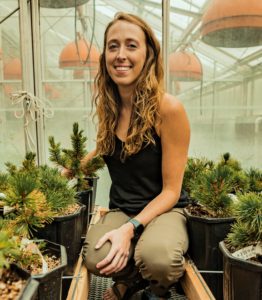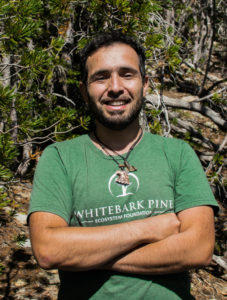Student Spotlight: WPEF Webinar Series Team
The Whitebark Pine Ecosystem Foundation recently concluded a successful first semester of the High-Elevation, Five-Needle White Pines: Science and Management Webinar Series with over 280 people registering for the monthly series. It featured five webinars on various topics to include Clark’s nutcracker, tree microbiomes and the Greater Yellowstone Ecosystem. All webinars were recorded and can be viewed on the WPEF’s Whitebark Flix YouTube Channel. A sincere thank you to the webinar speakers who volunteered their time and expertise!
The newly launched program was initiated and coordinated by WPEF Board Members Drs. Cara Nelson and Danielle Ulrich and organized by an outstanding team of graduate student researchers. In this student spotlight, we feature more information about the WPEF Webinar Series team members who worked hard behind the scenes to launch this program. Learn more about their ongoing high-five pine research and other activities in each of their profiles.
After a summer break, the webinar series will return in the fall semester. If you are interested in presenting during the 2022–2023 academic year or serving on the webinar series team, please email the webinar coordinators.
Student Spotlights

Sean Hoy-Skubik holding the root system of a Great Basin bristlecone pine (Pinus longaeva) seedling
Sean Hoy-Skubik is a master’s student in the lab of Dr. Danielle Ulrich in the Department of Ecology at Montana State University. He also was the recipient of the 2021 John Van Gundy Student Scholarship administered by WPEF. Sean’s current research focuses on the physiological responses of high-elevation, five-needle pines to environmental stressors, with an emphasis on patterns of carbon allocation under stress. Climate change is an inescapable force that will shape the future of our world, and, as such, his research goals have always been to help understand and mitigate its effects. Sean’s work with high-five pine species combines that motivating force with a passion for physiology and learning about the incredible mechanisms that life uses to function and perform under stress. He plans to graduate this fall and pursue a career as a biologist. Outside of research, he enjoys exploring the beautiful ecosystems that he studies with his dog, whether by foot, bike or ski. Learn more about Sean’s work in a Today’s Voices of Conservation Science podcast episode and connect with him on LinkedIn.

Vlad Kovalenko in Glacier National Park, Montana
Vlad Kovalenko is a master’s student in systems ecology at the University of Montana. He is studying how the decline of whitebark pine in Glacier National Park is affecting the population of Clark’s nutcracker there. Specifically, Vlad is interested in modeling nutcracker abundance and occupancy using in-person surveys and also acoustic monitoring using Bayesian statistics. He loves the elegance of this bird-pine mutualism, while getting to spend time in the alpine! Vlad plans to complete his graduate degree this fall and further pursue a research career or PhD program. You can read more about his research and experience in these feature articles from the National Park Service and Glacier National Park Conservancy.

Chloe Wasteneys with her high-five pine seedlings in the greenhouse at the MSU Plant Growth Center
Chloe Wasteneys is a master’s student in the lab of Dr. Danielle Ulrich in the Department of Ecology at Montana State University. She also was the recipient of the 2021 WPEF Student Research Grant. Chloe’s research focuses on the physiological traits and stress resistances of three high-elevation pines (i.e., whitebark, limber, and Great Basin bristlecone pines). She cares about studying high-elevation, five-needle pines because of their beauty and the important ecological services that they provide. As she says, “To witness these huge pines in the alpine, where most plants struggle to survive, is a gift!” Chloe plans to graduate this fall and take some time to explore various plant physiology career paths, especially an interest in the field of viticulture. When she’s not working on her thesis, she likes to hang out with her dog, read, ski, listen to classic rock, and play board games with friends. You can follow Chloe on Twitter and connect with her on LinkedIn.

Enzo Martelli Moya in the field while sporting a WPEF t-shirt
Enzo Martelli Moya is a graduate student in the lab of Dr. Cara Nelson in the W.A. Franke College of Forestry and Conservation at the University of Montana. He recently defended his master’s thesis in forestry and is continuing on with a PhD program in forest and conservation sciences. Enzo’s line of research focuses on the ecology of high-elevation conifers, their response to restoration projects, and the efficacy of study designs. In recent years, his work has explored the ecological response of whitebark pine to prescribed burning and mechanical cutting in the Northwest Rockies region of the U.S. He also is studying the impact of lodgepole pine invasion on high-elevation Araucaria forests in the Andes Mountains of Chile. In his spare time, he enjoys learning about other fields like enology, foreign languages, and Latino American history. You can check out Enzo’s list of publications on Google Scholar and connect with him on LinkedIn.

